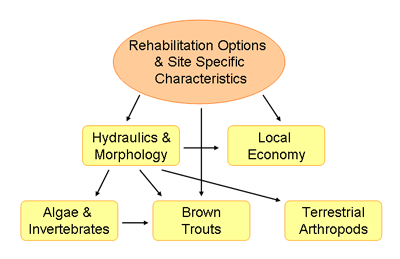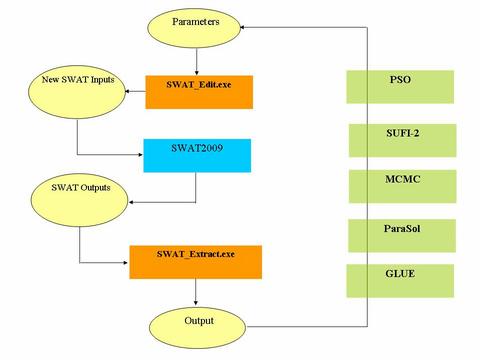Department Systems Analysis, Integrated Assessment and Modelling
Software
Santiago.jl: Sanitation System Alternative Generator
Santiago is a Julia package to generate appropriate sanitation system options. Given a set of sanitation technologies it
- finds all compatible systems;
- assesses the appropriateness of a technology for the given case (context);
- assesses the overall appropriateness of the generated sanitation systems for the given context;
- calculates the mass flows for each system for total phosphor, total nitrogen, totalsolids, and water (optionally with uncertainly quantification);
- selects a meaningful subset of suitable systems for the given context for further evaluation.
adaptMCMC: Adaptive Monte Carlo Markov Chain Sampler
User friendly R package to sample from unnormalized probability distributions as often needed for Bayesian inference. It implements the adaptive sampling algorithm proposed by Vihola (2012).
timedeppar: Infer Constant and Stochastic, Time-Dependent Model Parameters
R package for inferring constant and stochastic, time-dependent parameters to consider intrinsic stochasticity of a dynamic model and/or to analyze model structure modifications that could reduce model deficits. The concept is based on inferring time-dependent parameters as stochastic processes in the form of Ornstein-Uhlenbeck processes jointly with inferring constant model parameters and parameters of the Ornstein-Uhlenbeck processes. The package also contains functions to sample from and calculate densities of Ornstein-Uhlenbeck processes.
cran.r-project.org/package=timedeppar
References:
Tomassini, L., Reichert, P., Kuensch, H.-R. Buser, C., Knutti, R. and Borsuk, M.E. (2009) "A smoothing algorithm for estimating stochastic, continuous-time model parameters and its application to a simple climate model." Journal of the Royal Statistical Society: Series C (Applied Statistics) 58, 679-704, doi.org/10.1111/j.1467-9876.2009.00678.x
Reichert, P., and Mieleitner, J. (2009) "Analyzing input and structural uncertainty of nonlinear dynamic models with stochastic, time-dependent parameters." Water Resources Research, 45, W10402, doi.org/10.1029/2009WR007814
Reichert, P., Ammann, L. and Fenicia, F. (2021) "Potential and challenges of investigating intrinsic uncertainty of hydrological models with stochastic, time-dependent parameters", Water Resources Research 57(3), e2020WR028400, doi.org/10.1029/2020WR028400
Reichert, P. (2022) "timedeppar: An R package for inferring stochastic, time-dependent model parameters", in preparation.
utility: Construct, Evaluate and Plot Value and Utility Functions
R package for constructing and plotting objective hierarchies and associated value and utility functions. Evaluate the values and utilities and visualize the results as colored objective hierarchies or tables. Visualize uncertainty by plotting median and quantile intervals within the nodes of objective hierarchies. Get numerical results of the evaluations in standard R data types for further processing.
cran.r-project.org/package=utility
References:
Reichert, P., Schuwirth, N. and Langhans, S. Constructing, evaluating and visualizing value and utility functions for decision support. Environmental Modelling & Software 46, 283-291, 2013, doi.org/10.1016/j.envsoft.2013.01.017
Reichert, P., Langhans, S., Lienert, J. and Schuwirth, N. The Conceptual Foundation of Environmental Decision Support. Journal of Environmental Management 154, 316-332, 2015, doi.org/10.1016/j.jenvman.2015.01.053
ecosim: Toolbox for Aquatic Ecosystem Modeling
R package with classes and methods for implementing aquatic biogeochemical-ecological models, for running these models, and for visualizing their results.
stoichcalc: R Functions for Solving Stoichiometric Equations
Given a list of substance compositions, a list of substances involved in a process, and a list of constraints in addition to mass conservation of elementary constituents, the R package contains functions to build the substance composition matrix, to analyze the uniqueness of process stoichiometry, and to calculate stoichiometric coefficients if process stoichiometry is unique.
cran.r-project.org/package=stoichcalc
Reference:
Reichert, P. and Schuwirth, N., “A generic framework for deriving process stoichiometry in enviromental models”, Environmental Modelling and Software 25, 1241-1251, 2010, doi.org/10.1016/j.envsoft.2010.03.002
Former Software
SPUX
SPUX - “Scalable Package for Uncertainty Quantification”
SPUX is a modular framework for Bayesian inference and uncertainty quantification.
SPUX can be coupled with linear and nonlinear, deterministic and stochastic models.
SPUX supports model in any programming language (e.g. Python, R, Julia, C/C++, Fortran, Java).
SPUX scales effortlessly from serial run to parallel high performance computing clusters.
SPUX is application agnostic, with current examples in environmental data sciences.
SPUX is actively developed at Eawag, Swiss Federal Institute of Aquatic Science and Technology, by researchers in the High Performance Scientific Computing Group, https://www.eawag.ch/sc.
Scientific website of the SPUX project
You are welcome to browse through the results gallery of the models already coupled to spux.
This is free software, distributed under Apache (v2) License.
If you use this software, please cite (preprint available at http://arxiv.org/abs/1711.01410)

AQUASIM
Computer Program for the Identification and Simulation of Aquatic Systems
Short Program Description
In order to support environmental scientists in finding an «adequate» model of the system they are investigating, a computer program is necessary, which allows its users to perform simulations using different models, to assess the identifiability and to estimate the values of model parameters (using measured data), and to estimate prediction uncertainty. The computer program AQUASIM was developed to perform such analyses for technical and natural aquatic systems.
AQUASIM allows its users to define the spatial configuration of the system to be investigated as a set of compartments, which can be connected to each other by links. The available compartment types are mixed reactors, biofilm reactors (consisting of a biofilm and a bulk fluid phase), advective-diffusive reactors (plug flow reactors with or without dispersion), saturated soil columns (with sorption and pore volume exchange), river sections (describing water flow and substance transport and transformation in open channels) and lakes (describing stratification and substance transport and transformation in the water column of the lake and in adjacent sediment layers). Compartments can be connected by two types of links (lakes cannot be linked to other compartments). Advective links represent water flow and advective substance transport between compartments, including bifurcations and junctions. Diffusive links represent boundary layers or membranes, which can be penetrated selectively by certain substances. The user of the program is free in specifying any set of state variables and transformation processes to be active within the compartments. For the model as defined by the user, the program is able to perform simulations, sensitivity analyses and parameter estimations using measured data. These features make the program a very useful research tool. Calculated results can be plotted to the screen (window interface version only), written to a Post-Script file for transfer to a printer, or written to a text file for external post-processing.
Due to the possibility of starting with a simple model and gradually increasing model complexity later on by considering additional variables and processes, AQUASIM is also well suited for application by students in exercises accompanying a lecture on environmental modelling. The possibility of comparing different models and the capability of the program to estimate the uncertainty of calculated results (for a given, certain model) also stimulate discussions on the limits of the reliability of model predictions.
Three versions of the program are available. The window interface version uses the graphical user interface of the Microsoft Windows operating system, the character interface version can be run on a primitive teletype terminal, and the batch version is designed for long calculations to be submitted as batch jobs. The batch and character interface versions can be compiled on any operating system with any C++ compiler.
References
Please cite the use of the program by referring to one of the following publications. Besides acknowledging our work, this also allows the program users to identify other groups that use AQUASIM.
Survey of program features
Reichert, P., «AQUASIM - A tool for simulation and data analysis of aquatic systems», Water Sci. Tech., 30(2), 21-30, 1994. http://wst.iwaponline.com/content/30/2/21 (open access)
Survey of programming techniques
Reichert, P., «Design techniques of a computer program for the identification of processes and the simulation of water quality in aquatic systems», Environmental Software 10(3), 199-210, 1995. doi:10.1016/0266-9838(95)00010-I
Technical Documentation
Detailed technical report including manual for version 1.0
Reichert, P., Concepts underlying a computer program for the identification and simulation of aquatic systems, Schriftenreihe der EAWAG Nr. 7, Swiss Federal Institute for Environmental Science and Technology (EAWAG), CH-8600 Dübendorf, Switzerland, 386 p., 1994. pdf
Manual and tutorial for version 2.0/2.1:
Reichert, P., AQUASIM 2.0 - User Manual, Swiss Federal Institute for Environmental Science and Technology (EAWAG), CH-8600 Dübendorf, Switzerland, 214 p., 1998. pdf
Reichert, P., AQUASIM 2.0 - Tutorial, Swiss Federal Institute for Environmental Science and Technology (EAWAG), CH-8600 Dübendorf, Switzerland, 213 p., 1998. pdf
Software
Since 2013 AQUASIM is freely available to interested users.
The following zip file contains the executables for the three program versions and the required initialization file:
The following zip file contains the complete source code of all versions:
Examples
AQUASIM files of Tutorial Version 1.0: tutor10.zip
AQUASIM files of Tutorial Version 2.0: tutor20.zip
AQUASIM files of additional examples: examples.zip
AQUASIM users mailing list
We don't provide any technical support. We maintain an electronic user group list that facilitates contacts among AQUASIM users. If you send a request to aquasim-users@clutterlists.eawag.ch it is distributed to all members of the user group. These persons may give answers directly to the sender of the request or let the answer again be distributed to all user group members by sending it to aquasim-users@clutterlists.eawag.ch . The latter method should be preferred because other readers of the list may also be interested in the answer.
To subscribe to the AQUASIM user group list send an email with the subject "subscribe" (without quotation marks) to aquasim-users-join@lists.eawag.ch. To unsubscribe send an email with the subject "unsubscribe" (without quotation marks) to aquasim-users-request@lists.eawag.ch.
SIMBOX
Computer program for the simulation of material-, substance-, energy- and monetary flows in anthropogenic systems
The evaluation, modelling, controlling and assessment of substance flows is crucial for environmental management.
The aim of SIMBOX was to develop a tailor-made computer program to simulate and analyse time independent (stationary) as well as time dependent anthropogenic substance flows.
SIMBOX Input module:
SIMBOX offers different possibilities to define the system and to enter data:
- System definition : graphically interactive or using a system generator
- Data input: direct assigning data to the system elements or input of data from an EXCEL File with an interface.
- Data checking : using a table or graphically
- Definition of the model equations: Built in standard models or user defined Model equations for stationary as well as dynamic systems using an interface.
SIMBOX Calculation module:
SIMBOX offers many calculation modules for different purposes:
- Standard module including the calculation of transfer coefficients from mass flows, the determination of missing flows, the total amount of substance flows etc, all quantities with the corresponding uncertainty.
- Least square fit: best estimates for a given set of flow data.
- Simulations: Solving the model equations including uncertainty, sensitivity analysis and parameter variation respectively.
SIMBOX Export and graphical Visualisation module:
SIMBOX includes many possibilities to analyse and present the results.
- Visualisation of substance flows and their uncertainties.
- Tables and list of results.
- Data files to export results to other programs.
- Graphical representation of key quantities and key functions.
- Time series analysis , qualitative measures
SIMBOX has been further developed since 1991 and used by many companies, institutes and universities. Studies have been published in many publications and reports, see MMFA Framework.
Hardware requirements:
SIMBOX has been programmed in Rocky-Mountain-BASIC (HP-BASIC). The program development environment HTBasic is produced by TransEra Corporation 1049 South Orem Blvd. Orem, UT 84058, USA. In Switzerland HTBasic is distributed by Niederer Electronic AG, Gehrenacker 25, CH-9030 Abtwil.
Windows-Version:
Windows-Version:
- Requires Windows XP, Vista, Windows 7
- 512 MB RAM
- Requires 100 MB of free hard drive space
Literature:
Mathematical Material Flow Analysis Framework: MMFA Framework
Baccini P., Bader H.-P.: Regionaler Stoffhaushalt, Heidelberg Spektrum Verlag, 1996
Special publications and then search in for authors Bader, Scheidegger
Eawag- News 62
IRRM
The Integrative River Rehabilitation Model - A new tool for river rehabilitation projects
To support planning and decision-making of river rehabilation projects an integrative river rehabilitation model (IRRM) has been developed. The IRRM represents and quantifies the most significant effects of rehabilitation measures on:
- Morphology & Hydraulics
- Fish (Brown Trouts)
- Benthos (Macroinvertebrates & Algae)
- Shoreline Fauna (Arthropods)
- Local Economy

Since the topographic situation after a rehabilitation measure is unknown (e.g. where a gravel bar develops, which height, ...), all sub-models of the IRRM regard the project perimeter as a uniform system - without considering the spatial resolution (topography) explicitely. Thus, the IRRM is developed as a 1-dimensional model which simulates
- the expected river morphology
- reach specific means (e.g., mean velocity and depth)
- temporal dynamics (e.g., temporal progression of river bed siltation or of brown trouts) and temporal expected means (e.g. mean return period of floodplain inundation)
- spatial distributions of ecologically important characteristics (e.g. bivariate distribution of velocity and depth (habitat distribution) or relative shore line length)
Licence
The download and application of the IRRM are cost-free. However, to apply the IRRM the software „Analytica“ is required. See Lizenzen (in German) or directly under www.lumina.com
Model documentations (in German)
- Implementation of the IRRM as a probability network
- Documentation of the submodel „Morphology & Hydraulics“
- Documentation of the submodel „Algae & Invertebrates“
- Documentation of the submodel „Terrestrial Arthropods“
- Documentation of the submodel „Brown Trouts“
- Documentation of the submodel „Local Economy“
Table of planned and already implemented Model-Updates
Case Studies of the IRRM
- Case Study Moesa River at Grono (Widening performed in 1999)
- Case Study Thur River at Niederneunforn (Widening performed in 2004)
- Case Study Thur River at Weinfelden (Planned Widening)
- Case Study Rhone River near Sion (Planned Widening diploma thesis of Christel Dischinger, EPFL, short version)
Publications
- Schweizer, S., Borsuk, M.E., Jowett, I. and Reichert, P. Predicting Joint Frequency Distributions of Depth and Velocity for Instream Habitat Assessment. River. Res. Applic. 23, 287–302, 2007. http://dx.doi.org/10.1002/rra.980
- Schweizer, S., Borsuk, M.E., and Reichert, P. Predicting the Morphological and Hydraulic Consequences of River Rehabilitation. River. Res. Applic. 23,303–322, 2007. http://dx.doi.org/10.1002/rra.981
- Schweizer, S. and Reichert, P. Predicting the Biomass of Periphyton and Macroinvertebrate Functional Feeding Groups in Stream Reaches. 2007. (pdf)
- Borsuk, M.E., Reichert, P., Peter, A., Schager, E. and Burkhardt-Holm, P. Assessing the decline of brown trout (Salmo trutta) in Swiss
rivers using a Bayesian probability network. Ecological Modelling 192, 224–244, 2006. http://dx.doi.org/10.101/j.ecolmodel.2005.07.006 - Paetzold, A. Yoshimura, C., Tockner, K. Riparian Arthropod Responses to Flow Regulation
- Reichert, P., Borsuk, M.E., Hostmann, M., Schweizer, S., Spörri, C., Tockner, K. and Truffer, B. Concepts of decision support for river rehabilitation. Environmental Modelling & Software 22, 188-201, 2007. http://dx.doi.org/10.1016/j.envsoft.2005.07.017
- and River Channelisation. 2007. (pdf)
- Spörri, C., Borsuk, M.E., Peters, I. and Reichert, P. The Economic Impacts of River Rehabilitation: A Regional Input–Output Analysis. Ecological Economics 62, 341-351, 2007. http://dx.doi.org/10.1016/j.ecolecon.2006.07.001
SWAT
SWAT-CUP is a computer program for calibration of SWAT models. SWAT-CUP is a public domain program, and as such may be used and copied freely. The program links GLUE, ParaSol, SUFI2, MCMC, and PSO procedures to SWAT. It enables sensitivity analysis, calibration, validation, and uncertainty analysis of a SWAT model. The overall program structure is as shown in the Figure below.

In the new version, SWATCUP_4.3.1, a more powerful SWAT_Edit program is provided where ALL SWAT parameters are handled, including different soil layers and management rotation-operations, precipitation data, etc. The users are also allowed 20 “free” parameters placed at the end of *.gw files to use for their own programs, which may be linked to SWAT. This version also includes parallel processing (which is licensed but 20 simulation are allowed to be made for testing the program), visualization of the outlet locations using the Bing Map, creation of multi_objective objective function, extraction and calculation of 95PPU for all variables in output.rch, output.hru, and output.sub files without measurements, and one-at-a-time sensitivity analysis).
Upcoming functionalities of SWAT-CUP would include visualization of calibrated variables superimposed on Bing Map, as well as ArcSWAT's river map, and subbasins.
Publications
- Abbaspour et al. 2007 (Application of SUFI2 to Thur Watershed in Switzerland) [pdf, 465 KB]
- Abbaspour et al. 2004 (Application of SUFI2 to two landfills in Switzerland) [pdf, 1.9 MB]
- Schuol et al. 2008 (Application of SWAT in Western Africa) [pdf, 4.6 MB]
- Yang et al. 2008 (Comparison of five optimization programs) [pdf, 1.6 MB]
- Schuol et al. 2008 (Application of SWAT to Continent of Africa) [pdf, 2.1 MB]
- Faramarzi et al. 2009 (Application of SWAT in Iran) [pdf, 1.2 MB]
Downloads
Program software and manual can be downloaded from
https://www.2w2e.com.
MODAWEC
MODAWEC is a daily weather generator. It can generate daily precipitation, maximum temperature and minimum temperature based on monthly weather data. MODAWEC is the abbreviation of MOnthly to DAily WEather Convertor.
The current program is version 1.0. It supports generating daily weather data for EPIC (Environmental Policy Integrated Climate), GEPIC (GIS-based EPIC) and other environmental models.
MODAWEC is a public domain program, and as such may be used and copied free of charge for non-commercial uses.
Publications
- Liu et al. 2007a (Development of the GEPIC model) [pdf]
- Liu et al. 2007b (Application of GEPIC to China) [pdf]
- Liu J. et al. 2009 (Development of the MODAWEC model) [pdf]
- Liu J., 2009 (Development and application of GEPIC on a global scale) [pdf]
- Liu J. et al. 2008 (Application of MODAWEC and GEPIC in Sub-Saharan Africa) [pdf)
Downloads
GEPIC
GEPIC is a GIS-based agroecosystem model integrating a bio-physical EPIC model (Environmental Policy Integrated Climate) with a Geographic Information System (GIS). The GEPIC model can be used to simulate the spatial and temporal dynamics of the major processes of the soil–crop–atmosphere-management system.
The model has been used to study crop production, agricultural water uses, impacts of climate change on water and agricultural systems, virtual water and water footprint, biofuel-water relations on large scales (global, national, and river basin). It can also be used in other research areas e.g. water quality, N cycle, C cycle, water and wind erosion etc.
GEPIC is a public domain program, and as such may be used and copied free of charge for non-commercial uses. The current program is version 1.0.
Publications
- Liu et al. 2007a (Development of the GEPIC model) [pdf]
- Liu et al. 2007b (Application of GEPIC to China) [pdf]
- Liu J. et al. 2008 (Application of GEPIC to Sub-Saharan Africa) [pdf]
- Liu J. 2009 (Development and application of GEPIC on a global scale) [pdf]
Downloads
Note
Some antivirus programs might detect a false positive in the program download. The executable "replace_NaN.exe" might get tagged as "Unwanted program". Please ignore this false positive.


